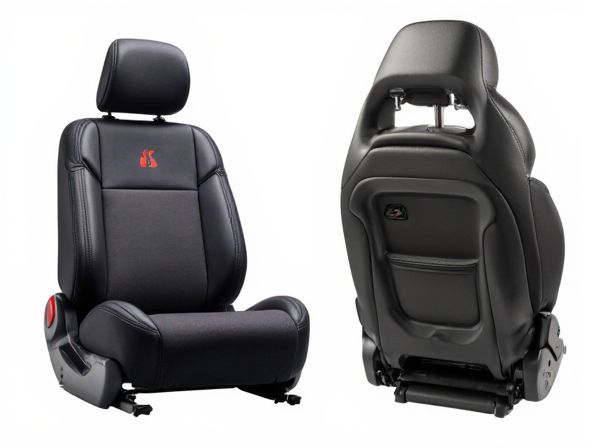
Photo illustration: Manual Seat vs Power Seat
Manual seats provide a cost-effective, reliable option by allowing you to adjust seat position using simple levers or knobs, ideal for basic comfort needs. Power seats offer enhanced convenience with electronic controls for precise adjustments, often including features such as memory settings and lumbar support to maximize comfort. Choosing between a manual seat and a power seat depends on your preference for ease of use, customization, and budget considerations.
Table of Comparison
| Feature | Manual Seat | Power Seat |
|---|---|---|
| Adjustment Mechanism | Mechanical levers and knobs | Electric motors controlled by buttons |
| Ease of Use | Requires physical effort | Effortless, precise adjustments |
| Adjustment Options | Basic (forward/backward, recline) | Multiple directions (height, tilt, lumbar) |
| Memory Function | Not available | Allows preset seat positions |
| Cost | Lower initial cost | Higher initial cost |
| Maintenance | Minimal, less prone to breakdown | May require electrical repairs |
| Common In | Economy and entry-level vehicles | Mid-range to luxury vehicles |
Introduction to Manual and Power Seats
Manual seats require physical effort to adjust position using levers or knobs, offering simplicity and cost-effectiveness ideal for budget-conscious drivers. Power seats utilize electric motors controlled by buttons or switches, providing precise and effortless adjustments for enhanced comfort and convenience. Both options cater to different user preferences, balancing affordability against advanced functionality.
Key Differences Between Manual and Power Seats
Manual seats require physical effort to adjust seat position using levers or knobs, offering straightforward, cost-effective functionality with less maintenance. Power seats rely on electric motors controlled by buttons or switches, providing precise, customizable positioning and often include memory settings for multiple drivers. The key differences lie in convenience, adjustment precision, and cost, making power seats preferable for enhanced comfort while manual seats remain favored for simplicity and reliability.
Comfort and Convenience Comparison
Manual seats offer direct physical adjustment, allowing users to customize seating position through levers and knobs, which can be less convenient but provide tactile feedback and reliability. Power seats enhance comfort by enabling precise, effortless adjustments via electronic controls, often with memory settings for multiple drivers, significantly improving ease of use and personalized support. The choice impacts long-term comfort and convenience, with power seats generally preferred for daily driving due to their adaptability and user-friendly operation.
Adjustability and Customization Features
Manual seats offer basic adjustability through levers and knobs, allowing for forward-backward sliding and seatback recline, but lack fine-tuning options. Power seats enhance customization with electric controls enabling precise adjustments in multiple directions, including lumbar support, height, tilt, and even memory settings for different drivers. Luxury vehicles often integrate power seats with advanced features such as massage functions and programmable presets for optimal comfort and ergonomics.
Installation and Maintenance Requirements
Manual seats require straightforward installation with basic tools, offering easy adjustments but limited customization. Power seats involve complex wiring and electronic components, necessitating professional installation and periodic checks to ensure motor functionality and electrical safety. Maintenance for manual seats is minimal, whereas power seats require regular inspections to prevent motor wear and electrical issues.
Cost Analysis: Initial and Long-Term Expenses
Manual seats typically have a lower initial cost compared to power seats, making them a budget-friendly option for new vehicle purchases. Over time, manual seats incur fewer maintenance and repair expenses due to their simpler mechanical design, resulting in reduced long-term costs. In contrast, power seats involve higher upfront costs and potential additional expenses related to motor replacements or electrical system failures.
Safety Features and Considerations
Manual seats offer basic safety benefits by allowing quick and simple adjustments without electrical components, reducing the risk of malfunction during emergencies. Power seats enhance safety through precise positioning options, enabling drivers to achieve optimal ergonomics that improve visibility and reduce fatigue-related accidents. However, power seats require regular maintenance to ensure electrical systems do not fail, which could hinder timely adjustments critical during sudden driving situations.
Suitability for Different Vehicles and Users
Manual seats are ideal for budget-friendly vehicles and users who prioritize simplicity and reliability, offering straightforward adjustment without reliance on electrical components. Power seats are suited for luxury or higher-end vehicles, catering to users who seek convenience and precise positioning, often featuring memory settings and multiple adjustment options. Vehicle type, user preference, and intended use significantly influence the choice between manual and power seats.
Reliability and Durability Factors
Manual seats offer higher reliability due to their simple mechanical components that are less prone to failure over time compared to power seats, which rely on electric motors and electronic controls susceptible to wear and malfunctions. Durability favors manual seats as they typically endure harsh conditions without loss of functionality, whereas power seats may experience issues like motor burnout or wiring problems, reducing their long-term effectiveness. Maintenance costs are generally lower for manual seats, making them a more durable option for drivers prioritizing longevity and consistent performance.
Which Option Is Right for You?
Choosing between a manual seat and a power seat depends on your preferences for convenience, budget, and adjustability. Manual seats offer lower cost and simplicity with basic adjustments but require more physical effort, making them suitable for drivers who value reliability and manual control. Power seats provide enhanced comfort and precise positioning with electric controls, ideal for those seeking ease of use, frequent adjustments, and luxury features in their vehicle.
 caratoz.com
caratoz.com